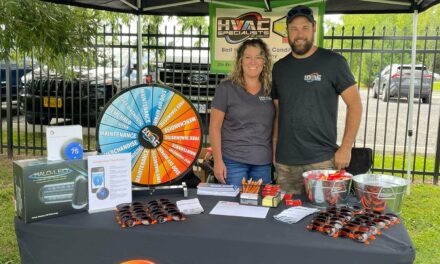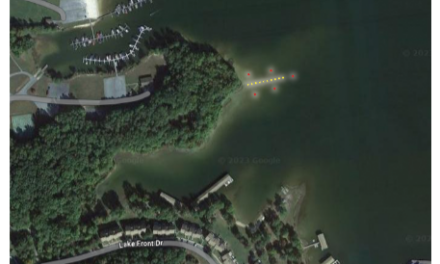
BY GREG BAKER
The Lake Anna Civic Association (LACA) Cyanobacteria Mitigation Program (CMP) Pilot/Demonstration Project in 2022 has been focused on four experimental areas of interest (AOI) with different environmental conditions and different size watersheds/flow rates.
Those four experimental AOIs are AOI-Pamunkey, AOI-Goldmine, AOI-Duckinhole, and AOI-Beverly. A map of the four experimental AOIs is available on the LACA website.
For this experiment (performed over the summer), LACA defined mitigation as a short-term measure/action that reduces the cyanobacteria population densities in the water.
LACA conducted a significant amount of research over the past four years and collected a large amount of data focused on establishing historical cyanobacteria population densities over that same time frame.
The result of the research and data analysis led LAAC volunteers to choose a hydrogen-peroxide based algaecide product called Lake Guard Oxy™ that is manufactured, distributed, and sold by BlueGreen Water Technologies.
The Lake Guard Oxy™ product was approved by the Virginia Department of Agriculture and Consumer Services (VDACS) on June 1st for use in Virginia. Details on the Lake Guard Oxy™ product can be found on the LACA website or on BlueGreen Water Technologies’ website. LACA utilized the services of SOLitude Lake Management, a Virginia-licensed applicator, to perform all treatments.
LACA developed four research questions for the 2022 Pilot/Demonstration Project. The group’s data monitoring plan and project scheduling were developed based on a need to gather sufficient data to assess outcomes that provide insights on each of the four research questions.
The four research questions focused on establishing the proper concentration levels of the hydrogen-peroxide algaecide product to achieve the desired decrease in cyanobacteria population densities and determining the timing of treatments.
SOLitude performed four application events with Lake Guard Oxy™ in all four of the experimental AOIs. The first event took place in mid-June in AOI-Pamunkey. The second and third application events took place in mid-July covering all four experimental AOIs. The fourth application event took place in mid-August in AOI-Pamunkey.
LACA collected data on a weekly basis at twelve (12) monitoring stations. During an application event, data is collected in each experimental AOI that was treated for five consecutive days.
To date LACA has 27 separate data collection dates starting in mid-May through mid-August resulting in an average collection event approximately every three days. As expected, due to the different environmental conditions and watershed areas, the data from each experimental AOI differ but insights are emerging from the data.
LACA intends to produce a final report in PowerPoint format by the end of the calendar year. The final report will be made public through posting on the LACA website.
AOI-Pamunkey was treated in mid-June with a preventative dose of approximately eight pounds of Lake Guard Oxy™ per acre. SOLitude also treated this experimental AOI in mid-July and mid-August with a maintenance dose of approximately four pounds of Lake Guard Oxy™ per acre. Cyanobacteria population densities remained stable throughout the experiment and water quality parameters such as pH and dissolved oxygen improved and remained at desired levels throughout the experiment.
AOI-Goldmine was treated in mid-July with a preventative treatment of four pounds of Lake Guard Oxy™ per acre. Data indicates that the cyanobacteria population in this experimental AOI rebounded after approximately one week.
AOI-Duckinhole was treated in mid-July with a preventative treatment of four pounds of Lake Guard Oxy™ per acre but cyanobacteria population growth was observed after several days so LACA conducted a re-treatment with approximately six pounds per acre. The re-treatment did not have the expected positive effects with a cyanobacteria population rebound to bloom conditions by August 2nd.
AOI-Beverly was treated in mid-July with a preventative treatment of four pounds of Lake Guard Oxy™ per acre. Data indicate that cyanobacteria population densities increased by August 2nd after an initial decrease. Recent data showed that cyanobacteria population densities decreased on August 10th but are increasing once again based on data from August 19th.
The early preventative treatment in experimental AOI-Pamunkey coupled with maintenance dosing every four weeks resulted in optimal results with cyanobacteria population densities remaining below pre-treatment levels throughout the experiment.
The results in experimental AOIs Goldmine, Duckinhole, and Beverly may be due to either waiting too late to conduct the preventative treatment or too low of a preventative dose concentration, or a combination of the timing and dosing levels.
LACA will review all data and consult with the product manufacturer and deliver final assessments in our final report by the end of the calendar year. LACA will also continue to monitor the stations in the experimental AOIs to glean further data insights as sun angles and air/water temperatures decrease.





















